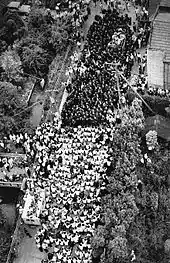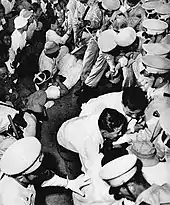Sunagawa Struggle
The Sunagawa Struggle (Japanese: 砂川闘争, Hepburn: Sunagawa Tōsō, also written as "Sunakawa") was a protest movement in Japan, starting in 1955 and continuing until 1957, against the expansion of the U.S. Air Force's Tachikawa Air Base into the nearby village of Sunagawa.[1] Arriving at the peak of a growing anti-base movement, "Bloody Sunagawa" is remembered as the most intense and violent protest against U.S. military bases in Japan.[1]

Origins

On May 4, 1955, an official from the Tachikawa branch of the Tokyo Procurement Office (調達庁東京, Chōtatsu-chō Tōkyō) approached the mayor of Sunagawa to inform him of plans to expand the runway of the Tachikawa airfield.[2] The U.S. Air Force had deemed the expansion necessary in order for the runway to accommodate larger, jet-powered bombers.[1] The result of an order from officials of the American-occupied base, it would have involved the confiscation of farmland and the eviction of 140 families.[2] Many of the farmers of Sunagawa village had been on the same piece of land for generations and fiercely resisted the confiscations.[2] Local families formed the Sunagawa Anti-Base Expansion Alliance (砂川基地拡張反対同盟, Sunagawa Kichi Kakuchō Hantai Dōmei) and barricaded their lands against government surveyors and their vehicles. Their struggle attracted the attention of the nationwide anti-base movement, and soon came to include regional and national labor unions affiliated with the left-leaning Sōhyō labor federation, radical student activists from the Zengakuren league of student associations, and Socialist Party Diet members.[1][2]
Escalation

The struggle escalated dramatically when police were sent in to remove the barricades. Since Sunagawa was very close to Tokyo, Zengakuren began busing in large numbers of students from Tokyo-area universities to bolster the manpower of the farmers.[1] The protests began to take on larger, nationwide implications, rhetorically portrayed as a decisive battle to protect Japan's "Peace Constitution" and resist American imperialism.[1] Soon the struggle became a media spectacle. Realizing they were in front of television cameras and receiving daily news coverage, the students of Zengakuren pioneered a new type of protest tactic. Unlike earlier student protesters, who had often armed themselves in their clashes with police, the Sunagawa protesters made a point of sitting in unarmed. Wearing white shirts and white headbands to make the blood more visible, they deliberately allowed the police to beat them without resisting.[1] The one-sided violence at Sunagawa proved successful in attracting sympathy to the protesters, leading to more favorable media coverage and further growth of the movement, and earning the struggle the sobriquet "Bloody Sunagawa" (流血の砂川, Ryūketsu no Sunagawa).[1]
Climax and resolution

The climax of the protests came in October 1956, when two thousand police officers, trying to evict the farmers, attacked six thousand protesters, resulting in a thousand people injured.[2] Despite the violence however, the police were not able to dislodge the protesters. Due to popular disapproval, the police were never able to mount such a violent attack again. With the surveyors unable to conduct their work to prepare for the runway expansion, the expansion plans were "indefinitely shelved" in late 1957, after which time the protests died away.[1] For a time, the U.S. military still maintained hopes that the runway expansion might be restarted after some time had passed, forcing the farmers to maintain some of their barricades indefinitely. However, in 1968, the U.S. Air Force officially gave notification to the Japanese government of cancellation of the expansion plans.[2] In 1977, following the conclusion of the Vietnam War, the base was handed over to the Japanese Self Defense Forces.[2]
Impact
The Sunagawa case not only led to the shelving of the runway expansion plans, but also helped convey to both Japanese and American leaders the magnitude of popular antipathy in Japan against US-occupied military bases. In part thanks to the bloody spectacle at Sunagawa, the Eisenhower administration in 1957 announced a massive 40 percent drawdown of U.S. troops in Japan, including all ground troops.[3] Historian Jennifer M. Miller has argued that the Sunagawa protests also convinced the United States to renegotiate the U.S.–Japan Security Treaty on new terms more favorable to Japan.[4] In addition, the tactics of unarmed protest pioneered by the Zengakuren students at Sunagawa were reused to even more effect in the 1960 Anpo Protests against the new, revised Treaty.[5]
Sunagawa Case
Amidst the protests, on July 8, 1957, in an event known as the Sunagawa Incident (砂川事件, Sunagawa Jiken), some protestors infiltrated the air base itself, and seven of them were arrested and charged with trespassing. Their case became a cause célèbre as it wound its way through the courts. In the 1959 Sunagawa Case (Sakata v. Japan), the Tokyo District Court initially found the U.S. bases, as well as the entire U.S.–Japan Security Treaty, unconstitutional and fully exonerated the protestors. However, the decision was rapidly overturned by the Supreme Court.[2]
See also
References
- Kapur, Nick (2018). Japan at the Crossroads: Conflict and Compromise after Anpo. Cambridge, MA: Harvard University Press. p. 15.
- Wright, Dustin (May 3, 2015). "'Sunagawa Struggle' ignited anti-U.S. base resistance across Japan". The Japan Times. Retrieved 22 January 2016.
- Miller, Jennifer (2019). Cold War Democracy: The United States and Japan. Cambridge, MA: Harvard University Press. p. 184.
- Miller, Jennifer (2019). Cold War Democracy: The United States and Japan. Cambridge, MA: Harvard University Press. pp. 189–90.
- Kapur, Nick (2018). Japan at the Crossroads: Conflict and Compromise after Anpo. Cambridge, MA: Harvard University Press. pp. 15–16.
Bibliography
- Kapur, Nick (2018). Japan at the Crossroads: Conflict and Compromise after Anpo. Cambridge, MA: Harvard University Press. ISBN 978-0674984424.
- Miller, Jennifer (2019). Cold War Democracy: The United States and Japan. Cambridge, MA: Harvard University Press. ISBN 978-0674976344.
- Wright, Dustin (May 3, 2015). "'Sunagawa Struggle' ignited anti-U.S. base resistance across Japan". The Japan Times. Retrieved 22 January 2016.
External links
| Wikimedia Commons has media related to Sunagawa struggle. |